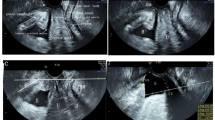Abstract
The pelvic organ prolapse quantification system (POP-Q) is currently the most quantitative, site-specific system for describing pelvic organ prolapse. To ensure that anatomic outcomes can be optimally assessed, investigators in the Pelvic Floor Disorders Network evaluated the impact of specific technique variations on POP-Q measurements performed on 133 patients by 16 examiners at seven sites. Values for genital hiatus and perineal body were higher when measured with maximal strain than on resting. With the exception of TVL, internal points did not differ significantly when measured with or without a speculum. The maximum extent of prolapse was best seen with the patient standing. These results suggest that genital hiatus and perineal body should be measured at rest and during straining, as the measurements may assess different aspects of pelvic floor function, and that internal points can be measured with or without a speculum. They also emphasize the value of the standing examination to observe the maximum extent of pelvic organ prolapse.
Similar content being viewed by others
Abbreviations
- POP:
-
pelvic organ prolapse
- GH:
-
genital hiatus
- PB:
-
perineal body
- TVL:
-
total vaginal length
References
Bump RC, Mattiasson A, Bo K et al (1996) The standardization of terminology of female pelvic organ prolapse and pelvic floor dysfunction. Am J Obstet Gynecol 175:10–17
Hall AF, Theofrastous JP, Cundiff GW et al (1996) Interobserver and intraobserver reliability of the proposed International Continence Society, Society of Gynecologic Surgeons, and American Urogynecologic Society pelvic organ prolapse classification system. Am J Obstet Gynecol 175:1467–1470; discussion 1470–1471
Kobak WH, Rosenberger K, Walters MD (1996) Interobserver variation in the assessment of pelvic organ prolapse. Int Urogynecol J 7:121–124
Barber MD, Lambers A, Visco AG et al (2000) Effect of patient position on clinical evaluation of pelvic organ prolapse. Obstet Gynecol 96:18–22
Swift SE (2000) The distribution of pelvic organ support in a population of female subjects seen for routine gynecologic health care. Am J Obstet Gynecol 183:277–285
Heit M, Culligan P, Rosenquist C et al (2002) Is pelvic organ prolapse a cause of pelvic or low back pain? Obstet Gynecol 99:23–28
Acknowledgements
The authors thank Dr Robert Park, the Chair of the PFDN Steering Committee, for his contributions to the Network.
Author information
Authors and Affiliations
Corresponding author
Additional information
An erratum to this article can be found at http://dx.doi.org/10.1007/s00192-003-1052-5
For the Pelvic Floor Disorders Network (PFDN)
Supported by grants from the National Institute of Child Health and Human Development (U01HD41249,U10 HD41268, U10 HD41248, U10 HD41250, U10 HD41261, U10 HD41263, U10 HD41269, and U10 HD41267).
Editorial Comment: This is a well conceived and clearly described study by the investigators of the Pelvic Floor Dysfunction Network. It carefully evaluates whether some of the most common variations in investigator use of the POP-Q examination results in any important differences in the measured POP-Q points. The authors demonstrate that use of a speculum rather than fingers for retraction when measuring POP-Q points does not result in any frequent or any important changes in those measurements when small numbers of patients from multiple examiners are combined for analysis. They also confirm that the standing examination is probably preferable when trying to evaluate the maximum extent of prolapse.
Rights and permissions
About this article
Cite this article
Visco, A.G., Wei, J.T., McClure, L.A. et al. Effects of examination technique modifications on pelvic organ prolapse quantification (POP-Q) results. Int Urogynecol J 14, 136–140 (2003). https://doi.org/10.1007/s00192-002-1030-3
Received:
Accepted:
Published:
Issue Date:
DOI: https://doi.org/10.1007/s00192-002-1030-3




